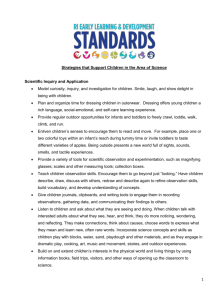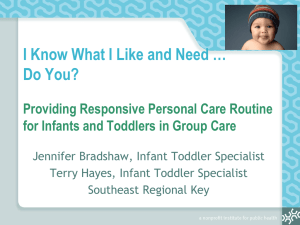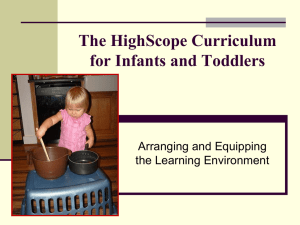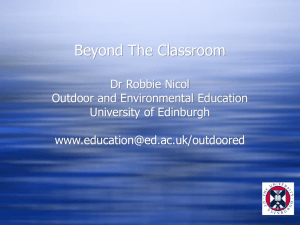The High/Scope Approach for Infants and Toddlers
advertisement
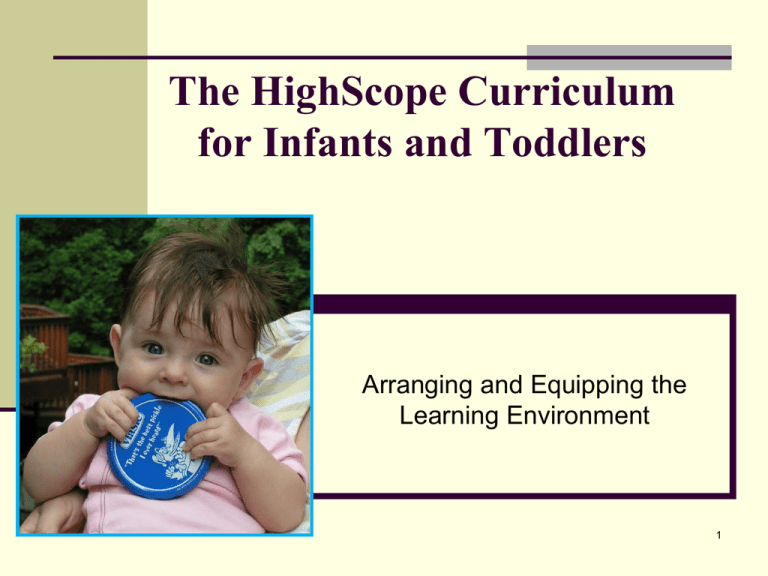
The HighScope Curriculum for Infants and Toddlers Arranging and Equipping the Learning Environment 1 Objectives • Discuss Heuristic Play and Treasure Baskets. • Develop plans for incorporating non-typical materials into the learning environment. • Organize sensory-motor materials that appeal to all of children’s senses. • Discuss rationale for outdoor play. • Identify guidelines for outdoor play space. • Examine your own care and play spaces in terms of the guidelines. 2 Thoughts About Yesterday… 4 Corners: When it comes to cleaning up around the house, I’m most like a: Boat Bus Hot Air Balloon Train 3 Experiencing Heuristic Play 1. Find a partner. 2. With your partner, spend some time using the materials around the room in your own way. 3. Discuss what you learned as you worked with these materials. 4. Look at the KDIs and discuss what infants and toddlers learn. 4 What does Heuristic mean? • Of, relating to, or constituting an educational method in which students learn through their own investigation. (American Heritage College Dictionary) • Methods that help in problem solving. • Experimentation; trial and error. • A planned activity which offers children the opportunity to explore various items using and developing all of their senses. 5 Why is Heuristic Play Important? Discuss: • Why is Heuristic play important to young children’s development? • What is so different about it versus choice time or free play? • What is different about the materials? 6 Heuristic Play Helps Develop: • Manipulative skills • Imagination • Memory • Problem solving • Concentration • Anticipation • Sequencing • Cause & effect • Key Developmental Indicators (KDIs) 7 Heuristic Play • Is different from choice or free play because it is more focused and purposeful. • More engagement and concentrated play. • Less noise. • More problem solving. 8 Heuristic Materials Are: • Open-ended: Can be combined and used in many ways which leads to more development. • Challenging and encourages problem solving. • Familiar everyday items. • Made of many different textures. • Unique in size, shape, and weight. 9 How does Heuristic Play Relate to Active Learning? 1. Materials 2. Manipulation 3. Choice 4. Child communication, language, and thought 5. Adult scaffolding 10 Points to Consider • Learning occurs when children can manipulate and choose materials, and can freely use their whole bodies and all their senses to do so. • When children are actively engaged and given choices, this helps to reduce many frustrations and power struggles. • When children have a variety of materials to choose from that appeal to multiple senses, there are less conflicts and more concentration. 11 Watch Infants and Toddlers Investigating Heuristic Play With Objects 12 You are most important? Your engagement with their play only enhances their learning, so: • • • • • • Observe Be responsive Let babies make the choices Allow children time to problem solve Imitate their actions Follow their lead 13 Let’s Try it Out! 1) Divide into groups of 3s. (Teacher, 2 children) 2) Choose 1-2 interaction strategies and materials. Role play this with your children. When you hear the signal, switch roles. 3) Discuss: • Which strategies came easy to you and which ones were more difficult? • What struck you about the interaction that would not have happened if you were not there? 14 So what does this mean for infants and non-mobile infants and toddlers? 15 Active Learning • Is different for non-mobile infants and toddlers. • Non-mobile children learn just as much as mobile children if they are not confined in a seat or play pen and interesting materials are within reach. • The types of materials that we choose for infants and non-mobile children are what they learn. 16 Treasure Baskets 17 What is a Treasure Basket? • A shallow sturdy basket containing a collection of everyday familiar and natural items for babies and toddlers to play with. Website Resources for Treasure Baskets • The items in the basket should vary in weight, www.heritagetreasurebaskets.co.uk size, texture, color, taste, temperature and www.treasurebaskets.org sound. • Materials appeal to all senses (taste, touch, smell, hear, see). 18 Look at the following videotape… Infants at Work 19 What are your thoughts about treasure baskets for infants? 20 Materials and Safety • What materials would you have out for children at all times and what materials would you not? Materials that are not safe (Think Safety!!) without the caregiver’s interaction, • What materials are you providing? only bring outuncomfortable when What other materials you are could there!you suggest that provides the same or similar experience? (Think outside the box) • How would you make these materials accessible to your children (mixed ages)? • What parts of the schedule and routine would you offer these materials? 21 Logistics of Heuristic Play and Treasure Baskets 1. Incorporate safe materials in the environment. 2. Offer these materials at appropriate times of the day: • • • • Group times Awake times Choice times Outside times 3. Allow time for investigation. 4. You play an important role in their learning so you need to be present. 22 Taking a Look at Your Materials • Look at the listing of materials on page 21-22 in TB. Place a checkmark next to items that you would like to incorporate into your rooms. • Discuss with a partner, how you can begin to get these materials. 23 Organizing Materials and Making them Accessible • Using area cards, place the materials in the various areas that you feel they should go • Discuss: - What materials did you have difficulty placing? What materials would be accessible? Why is accessibility important for infants and toddlers? 24 Why Make Materials Accessible to Infants and Toddlers? • • • • • Materials can be stored in more than one area Making materials accessible promotes children’s: initiative curiosity independence problem solving Sample list on pages 265-267 of Tender Care (2nd ed.). Children need access to messy materials (e.g., water, sand, paint, dough, etc.). We as caregivers need to support and provide these sensory experiences Some materials may need to be accessible to toddlers but out of reach for infants: - Store materials in clear plastic containers with large screwon lids so toddlers can unscrew but not infants. 25 Organizing the Environment with Labels • Infants and toddlers respond to labels as objects to explore–to pick at, mouth, remove--normal, sensory-motor behavior. • Objects are objects, if a bead is taped to a container it is fair game as well as the other beads in container. At this age the actual object does not work as a label. • Need organization on shelves and containers. • Older toddlers begin to make connections between labels and storage on the shelves. Some may see labels as a form of puzzle to master. 26 Piaget’s Development of Representation Rattle Sign Symbol Word Drawing or Sketch Photo or Tracing Index Object Real Thing Organizing the Environment with Labels (cont.) • Use clear containers so children can see what is inside. Out of sight-out of mind! • Labels are more significant for adults because it gives a sense of order and they will be the ones most likely cleaning up. • Labels begin to make sense to children when they begin at age 3-4 to develop a notion of representation or hold mental images in mind. • Labels in an infant and toddler environment lend a sense of organization to adults that may be translated to children as they learn that materials are available and accessible to them on a daily basis. Learn from example. 28 Assessing Your Indoor Space 1. Turn back to your drawings of your own rooms. 2. Using page 37, follow the instructions and assess your environment according to the guidelines. 3. Redraw your space to include the new changes. 4. Share as a whole group. 29 Outdoor Play Space for ITs? Answers these questions: 1. Why are caregivers reluctant to go outside? 2. What do your ITs like to do outside? 3. What learning occurs outside (KDIs)? 4. Why is outdoor play important to ITs? 5. What are the benefits of being outside? Discuss as a whole group. 30 Benefits of Outdoor Play! 1. Air temperature changes improve children’s ability to adapt to cold and heat. 2. Cool and colder air improves appetite and energizes people of all ages. 3. Exercise and fresh air support children’s natural rhythm of sleep and wakefulness. 31 Benefits of Outdoor Play! (cont.) 4. Cooler, outdoor air generally contains more moisture and is easier on the body’s airways and immune system than drier heated indoor air. 5. Outdoor play provides a relaxing alternative to crowded living conditions. 6. Outdoor play provides many opportunities for sensory-motor learning. 7. Outdoor play puts children in direct contact with nature and living things. 32 What you Need for an Outdoor Play Yard for Infants & Toddlers • Turn to page 34 in TB. • Watch Outdoor Play in this video and look for these features. 33 Assessing Your Outdoor Play Space 1. Turn back to your drawings of your own outdoor space. 2. Using page 38, follow the instructions and assess your outdoor environment according to the guidelines. 3. Redraw your play yard to include the new changes. 4. Share as a whole group. 34 Implementation Plans • Turn to page 39-40 and complete your implementation plans for your indoor and outdoor learning environments. • Discuss assignments on page 41. • Complete evaluations. 35
